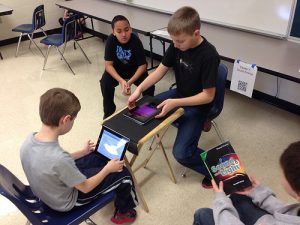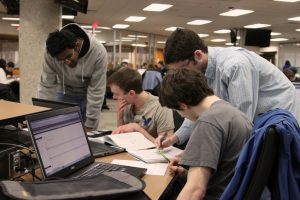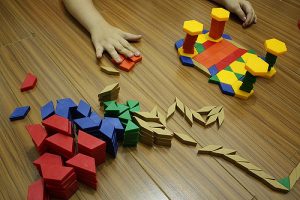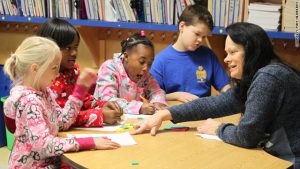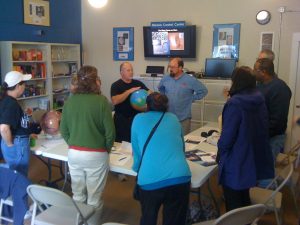Abstract for Interview- Elementary Teacher Grade 5-Multi-Disciplinary Teacher-Interviewed Specifically about Math Programming
Interview Length 22 minutes. The teacher I interviewed is from a city of approximately 100, 000 people in Northern Ontario, Canada. The interview took place during the lunch hour in the staff room in the elementary school where we both work. The elementary school houses students from JK-8 and the school population is approximately 550 students. It is a relatively new school and it has several shared laptop carts, several shared I-Pad carts and an Interactive Whiteboard in every classroom. The interviewee is in her 40’s and has been teaching full time for for 5 years and had previously worked as an occassional teacher for 2 years. Prior to this she worked as an educational assistant for 7 years and prior to that worked as an early childhood educator for 12 years. She has taught grade 5, and worked as a primary planning teacher where she was responsible for teaching the music program from grades K-8. She has a keen interest in technology tools. I asked questions specific to technology and her mathematics teaching.
Three themes came out of the interview:
- There is a need for teacher training and support in regards to technology
2. Technology is being used in the math program, but not to full effect
3. A BYOD (Bring your own device) strategic plan may alleviate some of the concerns about BYOD in the elementary school and may provide students with more access to technology and more flexibility with the tools they are able to access and use in mathematics.
The integration of technology into the math programming in an elementary grade 5 classroom has many benefits but this also seems to go hand in hand with many issues. Most of these issues are around availability of technology, tech support and teacher training, but the risks inherant with students bringing their own devices to school was also apparent in the interview.
My colleague reported that she was incorporating technology in her math program across several of the elementary math strands including geometry, numeration, measurement and algebra. In addition, she reported enjoying incorporating the technology and a willingness to incorporate more as she learned about new applications. Although she mentioned that she often found out about new applications, websites etc through casual conversations in the school, she also noted that the training was lacking and that she felt that the training should be done in shorter sessions that concentrate on one topic or one tool to try instead of a longer session where too much information is given and teachers feel overwhelmed. She expressed that this type of training is often ineffective because either teachers don’t remember what they have learned or they do not have the proper technology or tools in order to practice what they have learned.
Although my colleague discussed the way she was incorporating technology in the math program, after reflecting on her comments I noticed that much of the technology use was for demonstration purposes or practice and review. If more training specifically focussed on ways that technology could be used for problem solving, creating or sharing and communicating amongst students perhaps this could also be explored in the classroom.
She also spoke about the BYOD (Bring your own device) situation in her classroom. Her concerns were around the students’ lack of responsibility when using technology, including inappropriate use and not thinking critically about their online behaviour. In addition, she was concerned about the students losing their devices and having both of these situations cause her to have to deal with issues that may get her into professional trouble.
The uniqueness of this interview lies in the fact that elementary educators are multidisciplinary educators yet in our school the science component is given to planning teachers to teach, so the homeroom teacher does not teach her own science. In this way, the integration of math/science/technology/engineering may happen less often. So the natural fit between STEM may be stifled. In addition, in the elementary school setting the educators are often the ones responsible for ensuring that the technology students bring to school is not lost, stolen or broken and if this happens the teacher often has to deal with this. This may be different in upper grades, a highschool setting and definitely in higher education settings. In addition, young students may not have an understanding of what it means to be a responsible digital citizen, and this should be explored along with technology so that the students can make informed and reasonable decisions about its use.
Transcript of Interview
Interviewer will be bolded throughout
How do currently utilize technology in your math program?
Well…I use the Smart Board regularly to demonstrate thinking and so that I can record their math strategies and so that we have a visual way to discuss them. I record number talk strategies as they are shared in class. I also use the I-Pads to, for example, practice elapsed time. Actually….I use the Porter website for that! I go on their website and pick a flight and then I tell the kids, “If I leave at 1:00 and land at 8:00 how much time has elapsed? They like that.
I also use the laptops and I-Pads for different games…I use “Math is Fun” and Prodigy.
So, when you are using these applications, are they aligned with the curriculum you are teaching?
Yes. So when we are doing multiplication the students went on “Grand Prix Auto” racing game for some reinforcing. I also use them for teaching concepts.
What are the differences in student engagement between using technology in math and not using technology?
Well….it depends on the student. Some think it is fun and some find it boring. I think overall they are more engaged.
Why do you think this is?
Well….I think they like the independence, and also the sounds, colors and action in the games.
Do you see any roadblocks to using technology in the math programming in your classroom?
Yes! Wifi is a big problem. The laptops themselves…well there’s not enough and when I sign them out a lot of them are broken. They are hard to book as well. I prefer I-Pads for quick learning and laptops have certain applications that can’t be used properly on the I-Pads so the laptops are helpful then.
Also some students bring in a device and then it won’t work and I don’t have the know-how to troubleshoot and there is no tech support so the student gets upset. Then some devices get stolen and then I have a crying student on my hands and an angry parent.
How do you think technology could be integrated more fully in the math programming in our school?
Well first of all training. Hands-on training in small steps. I have started inviting people to my class after school on Tuesdays for 30 minutes tops. They try some new technology and then get a chance to use it. When you throw everything at someone in one big course it is too overwhelming. Tech needs to be available when they are learning and the applications need to be available to teachers if they are being trained in their use.
Do you think ideas about how to use technology tools are being shared with the staff?
Well, I am open to learning anything new about technology. I love it. I don’t have anyone sharing with me, or if it is shared it is shared one-on-one informally…like in a hallway or over the lunch hour. Then I will try these “tips” out. But for many people it is in one ear and out the other because they don’t even know where to start.
Why did you take the initiative to voluntarily invite staff to technology training in your classroom after school?
Well…my friend (colleague) didn’t know how to use the Smart Board and I knew that I could be helpful. I’m excited about using technology in my classroom!
Do you allow students in your class to bring their own devices to school?
I haven’t started that yet. I usually wait until after Christmas.
Is there a reason that you wait and what are some of the perceived drawbacks of BYOD?
Well one time a kid in my class went on porn at home, saved it and then shared it at school. Also one student took a picture of another student and posted it on Facebook and then I got in trouble. The students need to learn responsibility and be held accountable which is hard to control.
What strands of math do you currently support with technology?
Geometry-looking at shapes and building 3-D objects and viewing these objects virtually.
Patterning-I use the “Patterns to Algebra” program on the Smart Board. It is found in the Smart Notebook program.
Number Sense-We use Grand Prix Auto
Measurement- I like using the Smart Board tools for this. The ruler that shouts out numbers is great!
I use the Smartboard for teaching and I use the I-Pad more for practice and consolidation.
Are the students using any of this math technology at home?
Well, I use the e-learning website to link to websites at home, but this year there are far more students not even accessing the e-learning.
Why do you think this is?
I think parents and kids are just too busy.
How do you see technology tools in the math program being of assistance to students who are struggling?
I really like “Prodigy” for that. It can be set up for the whole class or individualized for the grade level of the student. Two students I had last year, “A” and “D” were performing math below grade level so I used the I-Pad or laptop and they could practice math at their level.
Thank you for the interview! There are some really good discussion points here!
Interview Ended
